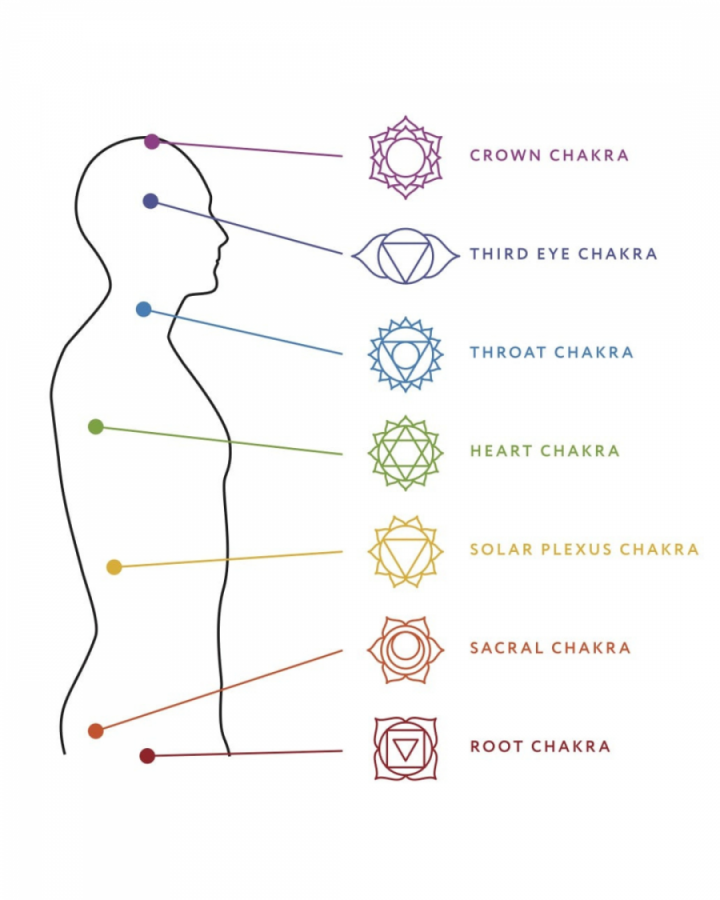
The chakra system is a system that’s discussed both in and out of yoga studios, amongst therapists, psychologists, doctors, nurses, bodyworkers, and anyone else with an interest in the process of their emotional and psychological development. You may also stumble upon chakra discussion in high schools, colleges, coffee shops, restaurants and bars. It’s definitely a topic that’s both accessible and incredibly scholarly.
According to Anodea Judith, author of Eastern Body Western Mind, “The Chakra system is a seven-leveled philosophical model of the universe.” and “A chakra is a center of organization that receives, assimilates, and expresses life force energy.” As a human being existing here on planet earth, you have seven main chakras that are stacked like a column from the base of your spine to the crown of your head.
There are other minor chakras, but you’ll usually see books, classes, and workshops on the seven major ones. The chakra system is a beautiful system to study and use in your own yoga practice, meditation practice, or as a way to navigate your thought patterns, tendencies, places of excess, deficiencies, and a path to discovering better balance.
Table of Contents:
- What exactly are chakras and how is the word pronounced?
- What are the seven chakras?
- First chakra: Muladhara (Root)
- Second chakra: Svadhisthana (Sacral)
- Third chakra: Manipura (Solar Plexus)
- Fourth chakra: Anahata (Heart)
- Fifth chakra: Vishuddha (Throat)
- Sixth chakra: Ajna (Third Eye)
- Seventh chakra: Sahasrara (Crown)
- How do I incorporate the chakras into my practice or my classes?
1. What exactly are chakras and how is the word pronounced?
Your body is full of energy and has many centers and pathways that hold or move that energy. All of these function from the three main areas that are known as nadis.
Three specific energy channels (of the nadis) in your body are:
- Ida (left)
- Pingala (right)
- Sushumna (center)
Sushumna is an energy channel in line with your spine while ida and pingala meet at the base of your spine, separate, meet again, separate, meet again, and so on. The meeting points of ida and pingala are where your chakras are located. A chakra may be understood as an energetic center that’s possibly spinning like a wheel.
The pronunciation of the word “chakra”
You can pronounce the “ch” in “chakra” like the “ch” sound in the word “patch” or “chocolate.” It’s often mispronounced like the sound the “sh” makes in “shoe.”
2. What are the seven chakras?
The first chakra begins to develop while you’re still in the womb and then the next six chakras develop as you grow up and move through your life. Once a chakra is developed, it doesn’t mean it’s perfected. As you grow and learn, your chakras will also come in and out of balance along with your life experiences. Balancing the chakras is an ongoing process and even once you feel balanced, you may come out of balance again. It’s kind of like how one day you can come into tree pose effortlessly and then on another day, you constantly fall out of it.
Each chakra is associated with a color, a location, and also physical and emotional ways to spot imbalances.
3. First chakra: Muladhara (Root)
The first chakra is called Muladhara, or The Root Chakra. It develops from the time you’re in the womb through about twelve months old. This is the chakra responsible for trust, grounding, feeling at home, and security. Its color is red and it’s located at the base of your spine.
When in balance: Good health, a sense of being grounded, healthy boundaries, and an ability to feel safe
When out of balance: Issues with boundaries, emotional eating, weight changes, and overall feelings of sluggishness
Healing practices to balance the first chakra:
- Receiving massages and other bodywork
- Grounding yoga asana
- Using essential oils such as: clove, copaiba, and cedarwood into your life
4. Second chakra: Svadhisthana (Sacral)
The second chakra is called Svadhisthana, or The Sacral Chakra. It develops from about six months to two years old. This is the chakra responsible for movement, sensation, emotion, pleasure, and needs. Its color is orange and it’s located at the lower abdominals.
When in balance: Healthy relationship to experiencing pleasure, the ability to adapt to changes, strong boundaries, a visible grace as you move
When out of balance: Pleasure addiction or a fear of pleasure, poor boundaries, obsessive attachment, an inability to feel
Healing practices to balance the second chakra:
- Working on boundaries
- Therapies that support healthy pleasure alignment or emotional release
- Using essential oils such as: cypress, clary sage, and cinnamon
5. Third chakra: Manipura (Solar Plexus)
The third chakra is called Manipura, or Solar Plexus. It develops from about eighteen months to four years old. This is the chakra responsible for power, energy, and self esteem. Its color is yellow and it’s located at the solar plexus.
When in balance: An ability to be a strong leader, confidence, healthy self esteem, and a sense of playfulness
When out of balance: Shaming behavior, physical abuse, or controlling behavior
Healing practices to balance the third chakra:
- Taking risks
- Incorporating a more vigorous yoga practice
- Using essential oils such as: blue tansy, rosemary, and lemon
6. Fourth chakra: Anahata (Heart)
The fourth chakra is called Anahata, or Heart Chakra. It develops from about four to seven years old. This is the chakra responsible for love, relationships, the ability to take things in and also the ability to reach out. Its color is green and it’s located at the center of the chest.
When in balance: Sense of compassion, lots of self love, good immunity, and an overall peaceful presence
When out of balance: Jealousy, fear of intimacy, loneliness, and lack of empathy
Healing practices to balance the fourth chakra:
- Breathwork (pranayama)
- Journaling
- Looking into existing assumptions about relationships
- Using essential oils such as: rose, ylang ylang, and peppermint
7. Fifth chakra: Vishuddha (Throat)
The fifth chakra is called Vishuddha, or Throat Chakra. It develops from about seven to twelve years old. This is the chakra responsible for communication, the ability to listen, and finding your voice. Its color is blue and it’s located at the throat.
When in balance: Clarity through self expression, the ability to speak with a purpose, and embodying the qualities of a good listener
When out of balance: Fear of talking or a tendency to talk incessantly, gossiping, and difficulty expressing emotional verbally
Healing practices to balance the fifth chakra include:
- Bodywork on the neck and shoulders
- Singing
- Chanting
- Telling stories
- Using essential oils such as: birch and lavender
8. Sixth chakra: Ajna (Third Eye)
The fifth chakra is called Ajna. It develops during adolescence. This is the chakra responsible for intuition, dreaming, and imagination. Its color is indigo and it’s located at the third eye.
When in balance: Good dream recall, strong intuition, and good perception
When out of balance: Nightmares, poor memory, difficulty envisioning the future, obsessions, and insensitivity
Healing practices to balance the sixth chakra include:
- Meditation
- Creative visual art
- Guided visualization
- Using essential oils such as: rosemary, clary sage, and lemongrass
9. Seventh chakra: Sahasrara (Crown)
The fifth chakra is called Sahasrara. It develops during early adulthood and beyond. This is the chakra responsible for belief systems, understanding, and connection to the divine. Its color is violet and it’s located at the crown of the head.
When in balance: General awareness, compassion, a feeling of being spiritually connected, and open-minded
When out of balance: Signs of confusion, over-intellectualization, learning difficulties, greed, and disassociation from the body
Healing practices to balance the seventh chakra include:
- Discipline in a spiritual practice like committing to prayers or japa
- Understanding your physical and emotional connection
- Using essential oils such as: frankincense, sandalwood, and roman chamomile

10. How do I incorporate the chakras into my yoga practice/classes?
The chakra system can be incorporated into yoga classes for kids, adults, and also used in your own offerings to individual clients. The chakras make great class themes, projects, and also meditation topics. You may also choose one chakra a week and try to incorporate some of the balancing practices into your self care while also noticing when the qualities of that chakra show up.
If you enjoy working with essential oils, you can also incorporate the essential oils associated with each chakra into your daily routine by adding them to your diffuser or into your body oils and lotions.
There are tons of yoga classes that may even have physical chakra themes like focusing on the heart chakra during a class that’s focused on back bends!
Learn more through our online courses:
SOURCES:







